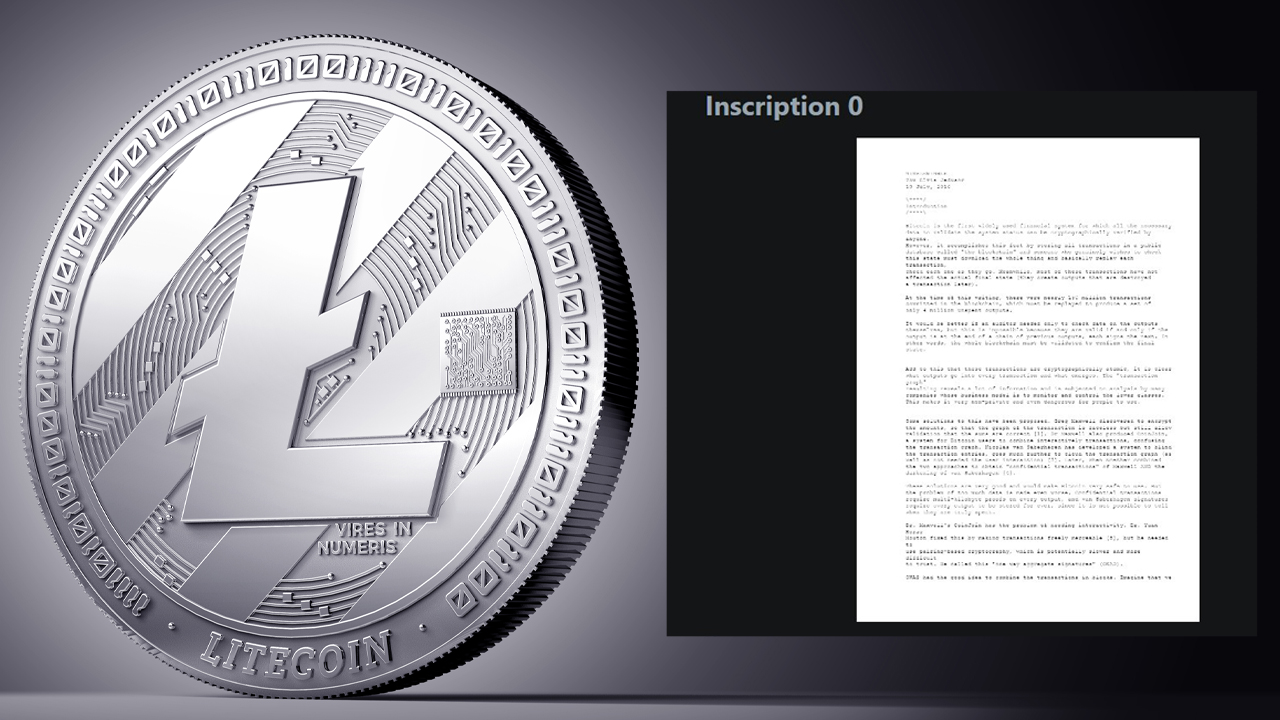Following an increasing trend of Ordinal inscriptions on the Bitcoin blockchain, the technology has been transferred to the Litecoin network, and the number of Litecoin inscriptions on the chain has passed 13,000. Software developer Anthony Guerrera made Ordinal inscriptions on the Litecoin network possible by receiving 22 Litecoins to transfer the technology to the proof-of-work (PoW) blockchain.
Digital collectibles are now possible on Litecoin
Supporters of the Litecoin (LTC) cryptocurrency network were happy to learn that Ordinal inscriptions are now possible on the network. Software developer Anthony Guerrera accepted a challenge to port the technology to Litecoin after the supply outgrew it five LTC to 22 tokens.
While Litecoin’s network has a number of differences, its codebase shares similarities with Bitcoin, including additions such as Segregated Witness (Segwit) and Taproot, which enable Ordinal inscriptions on the Litecoin network.
“JUST IN: BTC Ordinals are now on Litecoin,” Guerrera tweeted on February 18. The coder also shared the open source codebase hosted on Github and further explained that he wrote the first Ordinal onchain. The developer so:
The first Litecoin Ordinal has been entered on the Litecoin blockchain. The Mimblewimble white paper will live in Litecoin forever.
Since the codebase was released and the first Litecoin-based Ordinal inscription was shared on Twitter by Guerrera, the number of LTC-based Ordinals has grown significantly. At the time of writing, there are approximately 13,211 Ordinals on the Litecoin blockchain. Many people share their Litecoin Ordinal inscriptions on social media and promote their newly launched LTC based collections.
Meanwhile, the number of Ordinal inscriptions on the Bitcoin blockchain has passed 160,000, and the increasing trend shows no signs of slowing down. Furthermore, people are building infrastructure around Bitcoin-based Ordinals, such as minting tools that can issue an Ordinal inscription without a full node for a base fee, wallets and marketplaces.
There are also many collections competing to be “blue-chip” non-fungible tokens (NFTs) on the Bitcoin blockchain. It’s hard to say whether the trend will grow on Litecoin as it did on the Bitcoin network, but after Guerrera minted the first, thousands have followed. It will be interesting to see if digital collectibles minted on either Bitcoin or Litecoin will enter the established NFT market economy dominated by chains such as Ethereum.
Tags in this story
Anthony Guerrera, Bitcoin, Blockchain, blue-chip, codebase, collections, cryptocurrency, differences, digital collectibles, finance, Ethereum, github, infrastructure, litecoin, marketplaces, Mimblewimble, coining tools, NFTs, non-fungible tokens, Onchain, open source code , Ordinary Inscriptions, portert, Proof of Work, Segregated Witness, Social Media, Taproot, technology, trend, Wallets, Whitepaper
What do you think about Litecoin based Ordinal Inscriptions? Share your thoughts in the comments section below.
Jamie Redman
Jamie Redman is the news editor at Bitcoin.com News and a financial technology journalist living in Florida. Redman has been an active member of the cryptocurrency community since 2011. He has a passion for Bitcoin, open source and decentralized applications. Since September 2015, Redman has written more than 6,000 articles for Bitcoin.com News about the disruptive protocols emerging today.
Image credit: Shutterstock, Pixabay, Wiki Commons
Disclaimer: This article is for informational purposes only. It is not a direct offer or solicitation of an offer to buy or sell, or an endorsement or recommendation of products, services or companies. Bitcoin.com does not provide investment, tax, legal or accounting advice. Neither the company nor the author is directly or indirectly responsible for damages or losses caused or alleged to be caused by or in connection with the use of or reliance on content, goods or services mentioned in this article.



